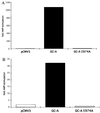A mutation of the atrial natriuretic peptide (guanylyl cyclase-A) receptor results in a constitutively hyperactive enzyme
- PMID: 9012805
- PMCID: PMC19534
- DOI: 10.1073/pnas.94.2.459
A mutation of the atrial natriuretic peptide (guanylyl cyclase-A) receptor results in a constitutively hyperactive enzyme
Abstract
Mutation of an invariant glutamate residue found within the catalytic domain of guanylyl cyclases resulted in a dramatic 14-fold increase in the activity of the guanylyl cyclase-A receptor. Even in the presence of Mn2+/Triton X-100, a treatment previously thought to yield hormone-independent and maximum cyclase activity, the mutant enzyme remained 7-fold more active; to our knowledge, this is the first example of a protein modification or of an added agent that significantly increases cyclase activity in the presence of Mn2+/Triton X-100. Intracellular concentrations of cGMP in cells expressing the mutant (E974A) cyclase were only marginally elevated by the addition of atrial natriuretic peptide, and in broken-cell preparations, the mutant enzyme also was relatively insensitive to ligand/regulatory nucleotide. The marked increase in cyclase activity was not due to a relief of protein kinase domain inhibition, since the point mutation caused 7- to 13-fold elevations in guanylyl cyclase-A activity when the protein kinase homology domain was deleted. The E974A mutation also altered the kinetics from positive cooperative to linear with respect to MnGTP, suggesting disruption of subunit-subunit interactions. Thus, a single point mutation within the catalytic domain of a guanylyl cyclase results in a constitutively hyperactive enzyme that is independent of protein kinase domain regulation.
Figures





Similar articles
-
The pseudokinase domains of guanylyl cyclase-A and -B allosterically increase the affinity of their catalytic domains for substrate.Sci Signal. 2019 Jan 29;12(566):eaau5378. doi: 10.1126/scisignal.aau5378. Sci Signal. 2019. PMID: 30696704 Free PMC article.
-
A disulfide-bridged mutant of natriuretic peptide receptor-A displays constitutive activity. Role of receptor dimerization in signal transduction.J Biol Chem. 1999 Apr 2;274(14):9752-9. doi: 10.1074/jbc.274.14.9752. J Biol Chem. 1999. PMID: 10092664
-
Structural insights into the ligand binding domains of membrane bound guanylyl cyclases and natriuretic peptide receptors.J Mol Biol. 2001 Aug 31;311(5):923-37. doi: 10.1006/jmbi.2001.4922. J Mol Biol. 2001. PMID: 11556325 Review.
-
Dimerization Domain of Retinal Membrane Guanylyl Cyclase 1 (RetGC1) Is an Essential Part of Guanylyl Cyclase-activating Protein (GCAP) Binding Interface.J Biol Chem. 2015 Aug 7;290(32):19584-96. doi: 10.1074/jbc.M115.661371. Epub 2015 Jun 22. J Biol Chem. 2015. PMID: 26100624 Free PMC article.
-
The guanylyl cyclase receptor family.New Biol. 1990 Jun;2(6):499-504. New Biol. 1990. PMID: 1982420 Review.
Cited by
-
Two amino acid substitutions convert a guanylyl cyclase, RetGC-1, into an adenylyl cyclase.Proc Natl Acad Sci U S A. 1998 May 26;95(11):5993-7. doi: 10.1073/pnas.95.11.5993. Proc Natl Acad Sci U S A. 1998. PMID: 9600905 Free PMC article.
-
Catalytic mechanism of the adenylyl and guanylyl cyclases: modeling and mutational analysis.Proc Natl Acad Sci U S A. 1997 Dec 9;94(25):13414-9. doi: 10.1073/pnas.94.25.13414. Proc Natl Acad Sci U S A. 1997. PMID: 9391039 Free PMC article.
-
The linker region in receptor guanylyl cyclases is a key regulatory module: mutational analysis of guanylyl cyclase C.J Biol Chem. 2009 Oct 2;284(40):27135-45. doi: 10.1074/jbc.M109.020032. Epub 2009 Jul 31. J Biol Chem. 2009. PMID: 19648115 Free PMC article.
-
A Glial K/Cl Transporter Controls Neuronal Receptive Ending Shape by Chloride Inhibition of an rGC.Cell. 2016 May 5;165(4):936-48. doi: 10.1016/j.cell.2016.03.026. Epub 2016 Apr 7. Cell. 2016. PMID: 27062922 Free PMC article.
-
Atrial natriuretic factor receptor guanylate cyclase, ANF-RGC, transduces two independent signals, ANF and Ca(2+).Front Mol Neurosci. 2014 Mar 17;7:17. doi: 10.3389/fnmol.2014.00017. eCollection 2014. Front Mol Neurosci. 2014. PMID: 24672425 Free PMC article. Review.
References
-
- Kamisaki Y, Saheki S, Nakane M, Palmieri J A, Kuno T, Chang B Y, Waldman S A, Murad F. J Biol Chem. 1986;261:7236–7241. - PubMed
-
- Harteneck C, Koesling D, Soling A, Schultz G, Böhme E. FEBS Lett. 1990;272:221–223. - PubMed
-
- Chinkers M, Wilson E M. J Biol Chem. 1992;267:18589–18597. - PubMed
-
- Iwata T, Uchida-Mizuno K, Katafuchi T, Ito T, Hagiwara H, Hirose S. J Biochem. 1991;110:35–39. - PubMed
-
- Lowe D G. Biochemistry. 1992;31:10421–10425. - PubMed
Publication types
MeSH terms
Substances
LinkOut - more resources
Full Text Sources

